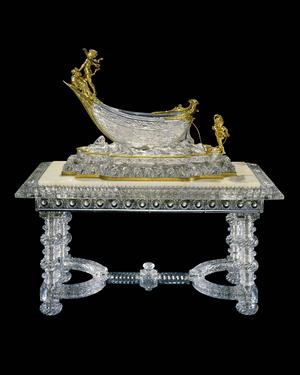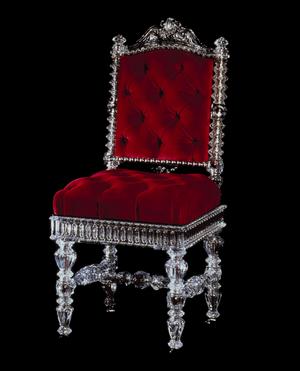Corning, New York - The very idea that a chair could glitter like a diamond, catch light like a colored gemstone, and still function as seating must have astounded those who first encountered glass furniture in the mid- to late- 19th century.

The Corning Museum of Glass aims to recapture that sense of bedazzlement in Glass of the Maharajahs: European Cut Glass Furnishings for Indian Royalty, on view from Friday, May 19 to November 30, 2006. The major exhibition is the first ever to examine a little-known chapter of design history, when British and French glass manufacturers tailored one-of-a-kind and limited production glass furniture to the tastes of the wealthy Indian elite. Many of these extraordinary pieces still reside in their original homes, principally in Rajasthan, but also in Madhya Pradesh, Punjab, Tamil Nadu, Patiala, and Andhra Pradesh.
Among the highlights of Glass of the Maharajahs will be a unique 11-foot-tall mirrored and intricately faceted glass wall cabinet, capped by four glass finials, on public view in the United States for the first time; towering candelabra; massive chandeliers; side tables; chairs; and even a crystal and horsehair fly whisk. Also on view, drawn from the Museum's own collection as well from public and private collections around the world, will be detailed design drawings, design books, printed catalogues, copies of period advertisements, and photographs of palace interiors taken years ago, and today.
Visitors will also encounter a French dressing table with a glass top and an oval mirror and candle holders supported by bronze cupids, which was made for a member of the French royal family. This exquisite piece will be displayed along with other examples of glass furniture spanning the early 19th to the early 20th centuries, giving visitors an overview of the early developments in glass furnishings outside the Indian market.
The Corning Museum will produce a 133-page, illustrated book on the production of glass furniture and lighting in the latter part of the 19th century as a companion to the exhibition. Entitled Glass of the Maharajahs, the volume will document the development of the Eastern market in the context of, among other influences, the fast-changing glass technology of the day, the world stage offered by the world’s fairs, and the changing tastes of the Maharajahs and other of India’s elite.

The Maharajahs’ taste in glass furniture was not universally shared in Europe. A reporter covering the 1878 Exposition Universelle in Paris noted that one of Osler’s mammoth chandeliers, while beautiful, was “… more fitted for the throne-room of some magnificent Eastern despot than for anything else.” And another commentator recounted that “considerable amusement is experienced by French visitors and foreigners at finding crystal used for chairs and sofas-probably furniture intended for the proverbial glass house.”
Says Jane Shadel Spillman, curator at The Corning Museum of Glass, and organizer of the exhibition, “During this period, British and French glass manufacturers applied new technology - the fashioning and annealing of large pieces of glass - to products conceived exclusively for an Eastern market. It was a fascinating moment in design history, a reversal of the more usual formula today, whereby Asian manufacturers tailor indigenous wares to the tastes of European markets.”
Two European companies dominated the Indian market: in France, the Cristalleries de Baccarat; and from the United Kingdom, F & C Osler of Birmingham. For much of the 19th century Osler even maintained a Calcutta showroom. Baccarat followed that lead by opening a showroom in Bombay in 1896.
One of the truly spectacular objects in the Glass of the Maharajahs, designed in 1889 by Baccarat, is a cut glass table of seeming perfection, its clear crystal legs shaped to resemble the turnings of carved wood and its top trimmed with classical detailing. Of the three of these tables that were made, only two survive: one is in the Corning Museum collection, and the other, once owned by Liberace, is now in a private collection in the Middle East. In the exhibition, atop this stunning table will be a spectacular cut glass and bronze sculpture of a boat, which Baccarat created for display in the 1900 World’s Fair in Paris: another just like it resides in the Lallgarh Palace in Bikaner.
“Today, glass tables, cabinets, and lighting fixtures are not at all unusual. But in the second half of the 19th century, it would have been truly remarkable to see such objects as these,” says David Whitehouse, executive director, The Corning Museum of Glass. “We hope to recapture the feeling of awe these sumptuous, over-the-top pieces of furniture would have evoked.”
For more information visit the website of the Corning Museum of Glass at www.cmog.org.




